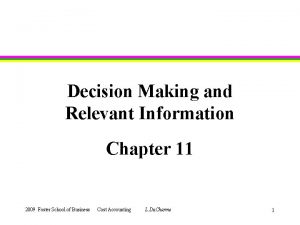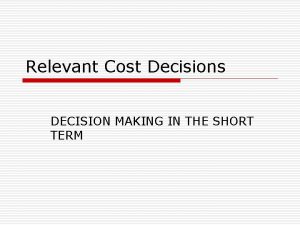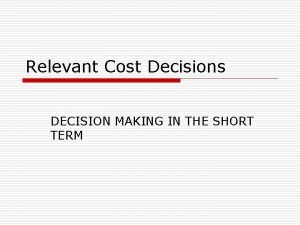Terminology and Decision Making Process Terminology Information Matrix








- Slides: 8

Terminology and Decision Making Process Terminology • Information Matrix – How consumers compare substitutable products. It takes into account both the Importance and Performance of attributes. • Product Hierarchy – a product hierarchy is a framework in the minds of consumers that helps them categorize products in comparison to other brands and product categories. The top of the category is the broadest term whereas the bottom level has direct competitors • Decision Making Stages – Extensive, Limited, and Routine Problem Solving Stage Extensive Limited Speed of Decision Slow Consideration Set Unknown Customer loyalty Openness to Brand Positioning Role of Brand None Large Small Category usage Medium Somewhat Defined Some Medium Marketing Strategy Routine Very Fast Clearly Defined Strong Small Large Product/Brand d 1

Product Hierarchy- Example of Choices for Dinner • Nearly all products have some type of competitive product that is (in some way) substitutable. A Product Hierarchy is an attempt to show the structure of brands & product categories within a customer's mind. • At the top of the hierarchy is the general need (Transportation, dinner, clean hair, etc) as you go down the hierarchy the products listed will be seen by customers are more similar. The final level will have specific products that customers will include in the information matrix. These are Products / Brands that have made it into the “Consideration Set” Dinner Dine-in Go-out Fast food Sit-down Buffett Mid-level Chili's Macaroni Grill Uncle Juilo's Fancy Red Lobster Restaurants that have made it into my “Consideration Set” 2

RPS, LPS, EPS- Examples of Purchasing a Laptop Dad: Extensive Problem Solving Performance Product Hierarchy: Blank Attribute IMP Me: Limited Problem Solving Performance Product Hierarchy: Mostly Defined Attribute Speed Software Warranty IMP 10 8 4 Dell 9 4 Gateway Other… 8 6 IT Professional: Routine Problem Solving. Performance Product Hierarchy: Clearly Defined Attribute Speed Software Warranty IMP 10 8 4 Dell 9 1 4 Gateway Lenova 6 8 8 6 6 9 3

EPS- Marketing Implications Extensive Problem Solving (EPS) When consumers are in EPS, their information matrix is blank; they are not aware of the companies working in the product area, nor how to compare them. Marketers can have great influence during this stage. Marketers can help prospects understand what is important in the product category, and how to evaluate products. Since marketers help form the importance weights, they can ensure their products align well with them. It is helpful to understand if it is the prospect that is new to an established product category [OR] the entire industry is in the early stage of the product life cycle (Introduction, Growth, Maturity, Decline) as marketing actions will be very different. Information Matrix Performance Attribute Importance Marketers should aide consumers by providing an explanation how this new (to them) product is similar to, but different than, other products. Help new customers develop a product hierarchy. Since prospects are new to this area explaining acronyms and words are important. Predominance of information provided from Marketers should be selling the category, emphasizing the brand as a leader (not product specific) 4

LPS- Marketing Implications Limited Problem Solving (LPS) During LPS, prospects know the type of product that will solve the problem, know how to compare competitors, however they do not know all the brands that compete. Prospects will continue to collect information regarding brands, which means Marketers can still affect attitudes/positioning of their brand. It is difficult for Marketers to get prospects to consider alternative importance weights during this stage. Understanding importance weights will allow Marketers to focus on what is important to prospects. Marketing efforts should stress product attribute performance compared to competitors. Information Matrix Performance Attribute Importance Detailed Specs 10 Obsolescence 5 Price 8 Finance terms 4 Dell 8 9 Gateway Lenovo Other… 5 6 ? 9 8 7 7 5

RPS- Marketing Implications Routine Problem Solving (RPS) Since, at this stage, prospects know 1) what is important and 2) how competitors perform, they will go from problem solving to purchase decision. The decision is often automatic and requires little thought. Since prospects do not gather more information, getting them to consider your brand is difficult. Marketers leading in the category should try to keep customers in this stage to increase brand loyalty. Simple reminder ads, competitive pricing and effective distribution might be enough to keep them on top. It is easier and less costly to keep a customer in this stage vs reacquiring a customer if you are dropped from consideration. Information Matrix Performance Attribute Importance Detailed Specs 10 Obsolescence 5 Price 8 Finance terms 4 Dell 8 9 8 7 Gateway Lenovo 5 6 9 9 8 9 7 8 Other 4 8 7 2 6

Additional Marketing Implications Ø For non-leaders (those not in the RPS consideration set) the goal is to, temporarily, move prospects to LPS so they will reconsider how to evaluate brands, or performance of brands (information matrix). Ø In both RPS and LPS changing prospects importance or performance weights is difficult and messaging needs to be carefully designed to motivate them. Ø In 1991 Rossiter, and. Emotions Donovan* used suggested eight types of motivations for consumers Eight. Percy, Typical to portray Motivations in two main sections. Motive Informational Transformational Ø Typical Emotional State Problem removal Anger --> Relief Problem avoidance Fear -->Relaxation Incomplete satisfaction Disappointment -->Optimism Mixed approach-avoidance Guilt -->Peace of mind Normal depletion Mild annoyance -->Convenience Sensory gratification Intellectual stimulation Social approval Dull -->Elated Bored -->Excited Apprehensive -->Flattered Special case of RPS- Commoditized products- When products are considered to perform equally on attributes, price & availability become critical. Brand loyalty is minimal or non-existent and the leader will always be at the mercy of competitor's pricing. 7 the goal is utilize a Ø It is important to note that the Informational motives are all negative reinforcing. Although, initially, *Rossiter, Percy, and Donovan (1991), “A Better Advertising Planning Grid”, Journal of Advertising Research, Oct. /Nov

Involvement & Marketing Strategies The Rossiter-Percy Grid also adds a dimension of Involvement in the decision (Low vs. High). The following presents advertising tactics for High Involvement / Informational Brand attitude strategies. High Involvement / Informational Brand attitude Strategy 1. Correct emotional portrayal is very important early in the product life cycle but becomes less important as the product category reaches maturity. 2. The target audience has to accept the ad's main points, but does not have to like the ad itself 3. The target audience's "Initial attitude" toward the brand is the overriding consideration that must be taken into account 4. Benefit claims must be pitched at an acceptable upper level of brand attitude (Don't overclaim) 5. Benefit claims must be convincing (Don't inadvertently underclaim) 6. For target audiences who have the objections to the brand, consider refutational approach (Directly address concerns) 7. If there is a well-entrenched competitor and your brand has an equivalence or advantages on important benefits, consider a comparative approach *Rossiter, Percy, and Donovan (1991), “A Better Advertising Planning Grid”, Journal of Advertising Research, Oct. /Nov 8
 Objectives of decision making
Objectives of decision making Dividend decision in financial management
Dividend decision in financial management Decision making and relevant information
Decision making and relevant information Steps in decision making
Steps in decision making Chapter 11 decision making and relevant information
Chapter 11 decision making and relevant information Chapter 11 decision making and relevant information
Chapter 11 decision making and relevant information Decision making and relevant information
Decision making and relevant information 5 step decision making process
5 step decision making process Decision making and relevant information
Decision making and relevant information















